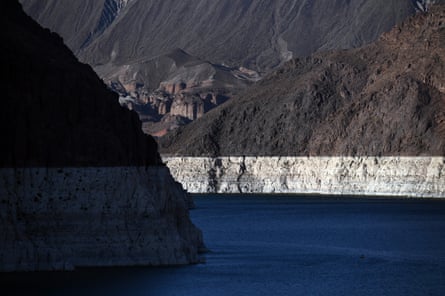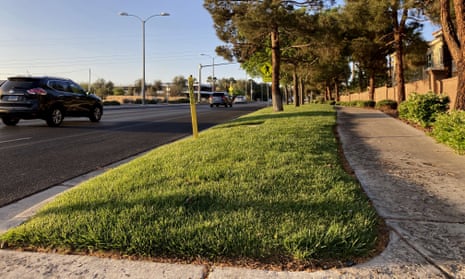In Sin City, one thing that will soon become unforgivable is useless grass.
A new Nevada law will outlaw about 40% of the grass in the Las Vegas area in an effort to conserve water amid a drought that is drying up the region’s primary water source: the Colorado River.
Other cities and states around the US have enacted temporary bans on lawns that must be watered, but legislation signed Friday by the state’s governor, Steve Sisolak, makes Nevada the first in the nation to enact a permanent ban on certain categories of grass.
Sisolak said last week that anyone flying into Las Vegas viewing the “bathtub rings” that delineate how high Lake Mead’s water levels used to be can see that conservation is needed.
“It’s incumbent upon us for the next generation to be more conscious of conservation and our natural resources, water being particularly important,” he said.
The ban targets what the Southern Nevada Water Authority calls “non-functional turf”. It applies to grass that virtually no one uses at office parks, street medians and the entrances to housing developments. It excludes single-family homes, parks and golf courses.
The measure will require the replacement of about 8 sq miles (21 sq km) of grass in the metro Las Vegas area. By ripping it out, water officials estimate the region can reduce annual water consumption by 15% and save about 14 gallons (53 liters) per person a day in a region with a population of about 2.3 million.
The ban was passed by state lawmakers with bipartisan support and backing from groups like Great Basin Water Network conservation group and the Southern Nevada Homebuilders’ Association, which wants to free up water to allow for projected growth and future construction.
When the ban takes effect in 2027, it will only apply to Southern Nevada Water Authority jurisdiction, which encompasses Las Vegas and its surrounding areas and relies on the Colorado River for 90% of its water supply.

As the region has grown, the agency has prohibited developers from planting grass front lawns in new subdivisions and has spent years offering some of the region’s most generous rebates to owners of older properties – up to $3 a sq ft (0.1 sq meters) – to tear out grass and replace it with drought-tolerant landscaping.
Water officials have said waning demand for those rebates has made bolder measures necessary. The legislation also mandates the formation of an advisory committee to carve out exceptions to the ban.
Other cities and states have enacted temporary grass bans during short-term droughts, but Nevada is the first place in the country to put in place a regional ban on certain uses of grass.
The ban came as the seven states that rely on the over-tapped Colorado River for water – Arizona, California, Colorado, Nevada, New Mexico, Utah and Wyoming – reckon with the prospect of a drier future.
Lake Mead and Lake Powell, the two reservoirs where Colorado River water is stored, are projected to shrink this year to levels that would trigger the first-ever official shortage declaration in the region and cut the amount allocated to Nevada and Arizona.
Water officials in both states have said that even without the cuts, they’ll still have enough water to accommodate projected population growth, but are working to limit certain kinds of consumption.
In Arizona, farmers in Pinal county south of Phoenix have had to stop irrigating their fields because of the cuts. Nevada stands to lose about 4% of its allocation, although the state has historically not used its entire share.
